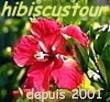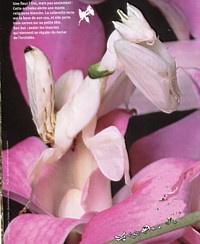-

"hibiscustour", three separate sites -
Islands and lagoons New Caledonia, Polynesia (part). -

Curiosity. Things, amazing, science, society.. -

Ideas perso. Household, Practical life, D.I.Y, Computering..
 
but reality |
  |
|
|
https://www.trop-hibiscus.com https://americanhibiscus.org/index.htm (for addresses) Watering ; during the hot season, the plant is going to absorb a significant quantity of water. Avoid to drown the roots while filling up the cup with water. During hot days, if the leaves are floppy, water it and it will soon regain vivacity. winter : place in a not too hot place, on open light, behind a pane (even directly exposed at sun). Vaporize the leaves and sprinkle them every two days with water at the temperature of the room (or more if the leaves softened too much. Note: Do not water tomuch as it is the tendency; the plant shows what is necessary and it can wait a little. Fertilizers : an ample supply of micronutrients is essential for proper growth of hibiscus. Fertilize lightly and often. Use fertilizers that include the trace elements such as iron, copper, boron, manganese, etc, wich are often limiting on alkaline soils. Most growers prefer low phosphate fertilizer such as a 7-2-7. Avoid ! high nitrogen fertilizers that may encourage leaf growth rather than flower production. Problems ; Premature flower bud drop is often a problem with hibiscus. Some varieties, especially some doubles, are characterized by premature bud drop. Bud drop can be caused by insects, overfertilization, poor drainage and excessive water.. But hibiscus are like ourselves : impredictable, they can grow a leave after another, make six flowers at a time and keep quiet without anything for a month.
|
Shis very common, but we like these delicate butterfly flowers. Orchids, or only some of them ? are parasite plants hanging from branches
of trees, like liana, of which these aerial roots.
Sciences et Avenir May 2004; Interview of the botanist Luc Gigord.
We admire both the most beautiful and the most spectacular ones but there are anonymous small ones at the edge of the
paths, in France and everywhere else in the world, from the sea level up to 4000 meters of altitude. They are almost exclusively fertilized by insects (bees,
bumblebees, flies, butterflies). In seldom cases, they self-fertilize or need birds help.
Described like sex-symbols, even as sexes in short, this Freudienne analysis dared by some must be moderated ; to reproduce itself, the orchis seeks to
attract the insect in order to use it like vector (conveying) of pollen for its fecundation. It is true that in certain cases, it imitates an insect
which will seem a good bargain by congeneric passing by there; the unhappy one will not obtain of what it hoped for but will be
covered with grains of pollen on its way out; in other case, it seeks only this sweetened pollen".
Trichoceros parviflorum. It is extraordinary that certain orchises mislead the insects by offering nothing but a lure without food. They will set out again about it
nevertheless covered with pollen ; sure they will not return, but no matter, the plant sends away a good part of its 50.000 seeds !
Birth and evolution of the species.
How the orchises could imitate an insect?
The author who speaks thus about Darwin evokes however further his theory on evolution: "randomly of an unspecified change, an orchis flowered without nectar and was spread" (..) why not to say then,
randomly unspecified change, an orchis was born with a false bee on its petals or, an orchis painted a bee above (after to have seen it with its
beautiful soft eyes) and we fall quickly into some ridiculous fact.
Left hand, a stamp "butterfly orchis"
Air orchis, Bucket orchid. Orchidée aérienne, Bucket orchid.
an elixir (odor, perfume called pheromon for the insects), attracts the males which set out again powdered with pollen.
Right hand, a white religious mante is coiled in an orchis to take a share of the insects it will attract.
The delicate green flange is the neck of the young lady and for the remainder, trust the small drawing at the top because only a white part of the lower part belongs to the orchis.
extracts from "Editions Bayard "astrapi" album jeunes.
Lower, an orchis imitates the bee.
Our orchid flowers when she wants ; not even each year. How it is adviced, on waters it very few. But she lives and does not seem to
bother too much.
Orchids a bit more special
" With more than 30.000 species, forms and colors do not miss ; one plant out every twelve is an orchis.
Orchises do not come from the bas of the ages, like all plants with flowers, at the beginning of the
cretaceous (- 130 million years), but only veiled 10 to 20 million years; the time of the cave man.
Yellow ophrys
Early in the season, in February, an orchis hatched in Spain: it will attract young inexperienced bumblebees which, not finding anything, will plough into the plant and
while fourraging, being powdered" with a maximum of pollen seeds.
This is not fair-play, but the mysteries of the beings are unsoundable, as we know it well. In all cases, the pretty one will not have needed to synthesize sugar, and it is energy saved.
Some others imitate another flower, appreciated by insects, which they mislead while producing in addition multiple perfumes which obstruct any identification.
This ophrys, queen of the kind, with the down and its colors yellow and gold, including two transverse bands, imitate the bee.
it is the great mystery of the life. According to the theory of the evolution of species of Darwin, preferably accepted instead of Lamarck theory (which however makes a noticed come back), the species would be created
randomly and only those being born armed well both to nourish and reproduce themselves, would survive; one added "the function make the organ", which corrects a little the rigour of the previous postulate, in particular
for their evolution ; Darwin, who had observed these plants, preferred to ignore them so much his theory was put to the test.
Did the orchises and their lures appear from the start by imitating an insect? do they created them after "having seen them"; the
second case is quite as incomprehensible (and for me improbable), because then how would have they could survive while being born without means of nourishing themselves.
Let us notice that lure or not, similar question are posed for the totality of the alive beings because links between plants and animals are common (see the
corals),
the lichen and the algae, certain trees which protect only the ants, and so much of others which we are unaware of.
Sciences and Avenir May 2004; Interview of the botanist Luc Gigord (continuation).
The Venus shoe, rare and protected species makes think of certain plants carnivores; the insect, attracted by the
yellow colour, slips and fall inside. It will arise from it without damage, but covered of pollen from the head to the legs.
Serapias cordigera
Orchis Mediterranean famous aphrodisiac; can alter the form of its petal to shelter the pollinating insect.
